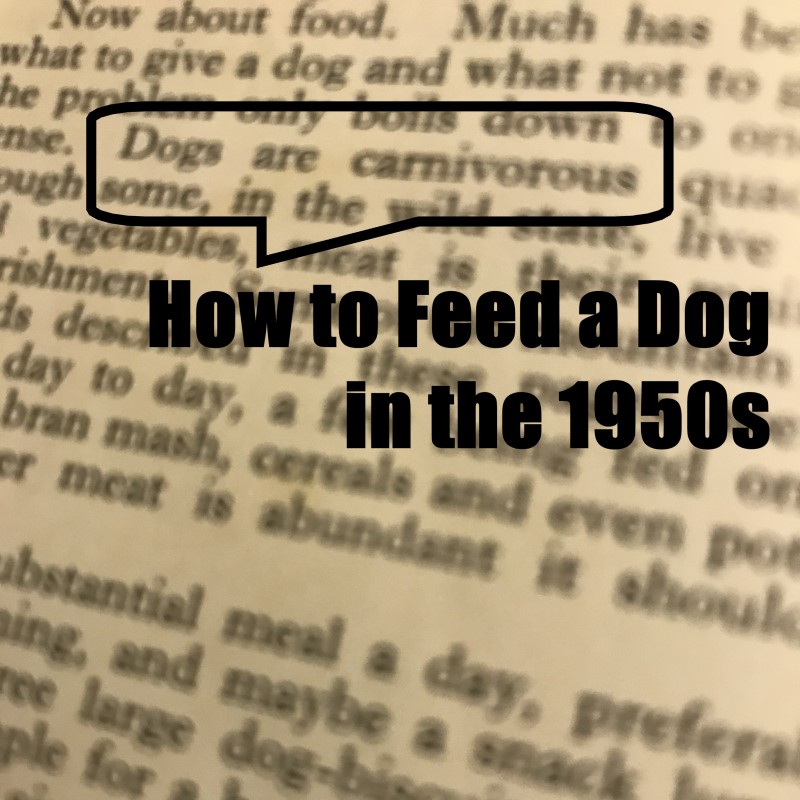How to Feed a Dog – 1950s

The below is an excerpt from The Observer’s Book of Dogs first published in 1951. It is an interesting account of how we perceived back then how to feed a dog.
Seven decades of science later and it would appear we have gone somewhat backwards, having transitioned our beliefs from dogs as “carnivorous quadrupeds” to grain-eating omnivores.
Some interesting points of note are the reference to feeding a dog raw meat, or perhaps cooked if necessary, and the emphasis on feeding meaty bones.
Excerpt from “The Observer’s Book of Dogs” on How to Feed a Dog in the 1950s:
Much has been written on what to give a dog and what not to give a dog, but the problem only boils down to one of common sense.
Dogs are carnivorous quadrupeds, and though some, in the wild state, live on fruit, fish and vegetables, meat is their main source of nourishment.
Some of the mountain and pastoral breeds described in these pages see little meat from day to day, a few being fed on curds and whey, bran mash, cereals and even potatoes; but wherever meat is abundant it should be given them.
One substantial meal a day, preferably in the early evening, and maybe a snack lunch-time of two or three large dog-biscuits with a bone to gnaw is ample for a healthy dog, no matter what its breed or size. Very few packs of Hounds are given more than the evening meal, though bones, and a liberal supply of fresh clean drinking water, are usually available.
Meat can be given raw or lightly cooked, or even fully cooked if the dog is fastidious at all. In such a case the stock or juice from the meat should be poured over a bowlful of meal whilst still boiling hot, letting the gravy soak into the meal, and cool well before feeding. Cut the meat into chunks according to the size of the dog and its tastes, mix with the Hound or Terrier meal, whichever it happens to be, add any leftover scraps from the family pot, and the meal is prepared.
This sort of meal suits the one-dog household or the kennel establishment of several dozen dogs… raw or lightly cooked meat, mixed with soaked meal and house scraps added to flavour.
For a large dog who likes lots of meat it is well worth cultivating a friendship with sheeps’ paunches, as, although these are rather messy things until cleaned and boiled, they furnish excellent nourishment and last for several days.
Should you find that none of the prepared biscuit meals available is suitable for your dog, try breaking up into small cubes any stale and hard brown bread there may be in the house, as a substitute. Many of the small breeds prefer brown bread to biscuit meal, and it is a good plan to cut the stale loaves into thick slices, bake well and crisp in the oven, and, after breaking into pieces and mixing with the meat, pour boiling stock or cabbage water over them.
Fish is usually liked as a change now and again, and a cheap and tasty meal can be prepared from boiled cods’ heads… but do be careful about bones, for they so easily stick into the throat and cause serious damage.
Bones are always a problem in feeding dogs, and yet so many people nonchalantly throw their dogs any bones which may be on their plates, irrespective of whether they are from poultry, game or fish, their “kindness” often causing severe distress.
Rabbit and bird bones are usually slender and of that compact tissue which tends to splinter into long needles, penetrating the gullet and resulting in choking the dog, or sometimes causing perforations of the bowels quite a time after the meal; so that for this reason such bones should not be given any dog.
All greens and most root vegetables are as good for dogs as humans, and few dogs refuse a meal, if hungry, merely because they scent a little green-stuff mixed with the meat and meal.
Turnip-tops and kale form a cheap and very nourishing body in any meal, their iodine content being good for the blood and the coat.
Potatoes, however, are not recommended, and are as unnatural to a dog as sweets and chocolates. In many agricultural countries potatoes have, perforce, to play some part in dog feeding, but a dog will have his full share of carbohydrates through his midday biscuits and evening meal or soaked stale bread without having potatoes as well.
Excerpt from The Observer’s Book of Dogs by Clifford L. B. Hubbard; Frederik Warne & Co; first published 1951.
Thoughts?
What are your thoughts on the above? What have we learned in the past 70 years? Are our dogs better off now than they are then? Has our knowledge of canine nutrition developed or regressed?
Comment!





